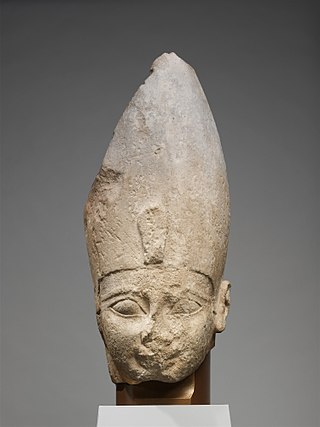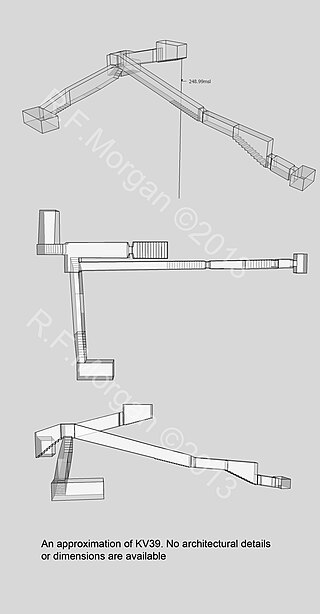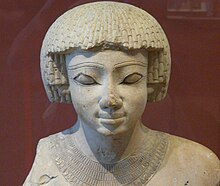
Ahmose I was a pharaoh and founder of the Eighteenth Dynasty of Egypt, classified as the first dynasty of the New Kingdom of Egypt, the era in which ancient Egypt achieved the peak of its power. He was a member of the Theban royal house, the son of pharaoh Seqenenre Tao and brother of the last pharaoh of the Seventeenth Dynasty, Kamose. During the reign of his father or grandfather, Thebes rebelled against the Hyksos, the rulers of Lower Egypt. When he was seven years old, his father was killed, and he was about ten when his brother died of unknown causes after reigning only three years. Ahmose I assumed the throne after the death of his brother, and upon coronation became known as Nebpehtyre, nb-pḥtj-rꜥ "The Lord of Strength is Ra".

Thutmose I was the third pharaoh of the 18th Dynasty of Egypt. He received the throne after the death of the previous king, Amenhotep I. During his reign, he campaigned deep into the Levant and Nubia, pushing the borders of Egypt farther than ever before in each region. He also built many temples in Egypt, and a tomb for himself in the Valley of the Kings; he is the first king confirmed to have done this.

Thutmose II was the fourth Pharaoh of the Eighteenth Dynasty of Egypt, and his reign is generally dated from 1493 to 1479 BC. Little is known about him and he is overshadowed by his father Thutmose I, half-sister and wife Hatshepsut, and son Thutmose III. He died around the age of 30 and his body was found in the Deir el-Bahri Cache above the Mortuary Temple of Hatshepsut.

Amenhotep I or Amenophis I, was the second Pharaoh of the 18th Dynasty of Egypt. His reign is generally dated from 1526 to 1506 BC.

The New Kingdom, also referred to as the Egyptian Empire, was the ancient Egyptian nation between the 16th century BC and the 11th century BC. This period of ancient Egyptian history covers the Eighteenth, Nineteenth, and Twentieth Dynasties. Through radiocarbon dating, the establishment of the New Kingdom has been placed between 1570 BC and 1544 BC. The New Kingdom followed the Second Intermediate Period and was succeeded by the Third Intermediate Period. It was the most prosperous time for the Egyptian people and marked the peak of Egypt's power.

Kamose was the last Pharaoh of the Theban Seventeenth Dynasty. He was possibly the son of Seqenenre Tao and Ahhotep I and the brother of Ahmose I, founder of the Eighteenth Dynasty. His reign fell at the very end of the Second Intermediate Period. Kamose is usually ascribed a reign of three years, although some scholars now favor giving him a longer reign of approximately five years.

Ahmose-Nefertari was the first Great Royal Wife of the 18th Dynasty of Ancient Egypt. She was a daughter of Seqenenre Tao and Ahhotep I, and royal sister and wife to Ahmose I. Her son Amenhotep I became pharaoh and she may have served as his regent when he was young. Ahmose-Nefertari was deified after her death.

The necropolis of Draʻ Abu el-Naga' is located on the West Bank of the Nile at Thebes, Egypt, just by the entrance of the dry bay that leads up to Deir el-Bahari and north of the necropolis of el-Assasif. The necropolis is located near the Valley of the Kings.

Tomb KV39 in Egypt's Valley of the Kings is one of the possible locations of the tomb of Pharaoh Amenhotep I. It is located high in the cliffs, away from the main valley bottom and other royal burials. It is in a small wadi that runs from the east side of Al-Qurn, directly under the ridge where the workmen's village of Deir el-Medina lies. The layout of the tomb is unique. It has two axes, one east and one south. Its construction seems to have occurred in three phases. It began as a simple straight axis tomb that never continued past the first room. In the subsequent phase, a series of long descending corridors and steps were cut to the east and south. It was discovered around 1900 by either Victor Loret or Macarious and Andraos but was not fully examined. It was excavated between 1989 and 1994 by John Rose and was further examined in 2002 by Ian Buckley. Based on the tomb's architecture and pottery found, it was likely cut in the early Eighteenth Dynasty, possibly for a queen. Fragmentary remains of burials were recovered from parts of the tomb but who they belong to is unknown. KV39's location may fit the description of the tomb of Amenhotep I given in the Abbott Papyrus but this is the subject of debate.

Tomb ANB is a sepulchre located in the west of the necropolis of Dra' Abu el-Naga', near Thebes, Egypt. It may well have been intended as the burial place of the 18th Dynasty Pharaoh Amenhotep I and his mother Ahmose-Nefertari.

Sekhemre Wadjkhaw Sobekemsaf I was a pharaoh of Egypt during the 17th Dynasty in the Second Intermediate Period.

The Valley of the Kings, also known as the Valley of the Gates of the Kings, is an area in Egypt where, for a period of nearly 500 years from the Eighteenth Dynasty to the Twentieth Dynasty, rock-cut tombs were excavated for pharaohs and powerful nobles under the New Kingdom of ancient Egypt.

Ahhotep I was an ancient Egyptian queen who lived circa 1560–1530 BC, during the end of the Seventeenth Dynasty of Egypt. She was the daughter of Queen Tetisheri and Senakhtenre Ahmose, and was probably the sister, as well as the queen consort, of Pharaoh Seqenenre Tao ll. Ahhotep I had a long and influential life. She ruled as regent for her son Ahmose I for a time.

Ahhotep II was an ancient Egyptian queen, and likely the Great Royal Wife of Pharaoh Kamose.

Ramose was an ancient Egyptian prince of the Eighteenth Dynasty; probably the son of Pharaoh Ahmose I.
Ahmose called Turo was Viceroy of Kush under Amenhotep I and Thutmose I.

The Eighteenth Dynasty of Egypt is classified as the first dynasty of the New Kingdom of Egypt, the era in which ancient Egypt achieved the peak of its power. The Eighteenth Dynasty spanned the period from 1550/1549 to 1292 BC. This dynasty is also known as the Thutmoside Dynasty) for the four pharaohs named Thutmose.
This page list topics related to ancient Egypt.
Kampp 150 is an ancient Egyptian tomb located in the Dra' Abu el-Naga' necropolis in Thebes. Based on a cartouche inscription, it probably dates back to the reign of Thutmose I of the Eighteenth Dynasty.

The shebyu collar is an ancient Egyptian necklace composed of one or more strands of disc beads. Collars specifically called shebyu by the ancient Egyptians are the two-stranded kind given to officials as part of a royal reward. However, the term is used in Egyptology to refer to any necklace composed of lenticular or disc beads regardless of the material.
















